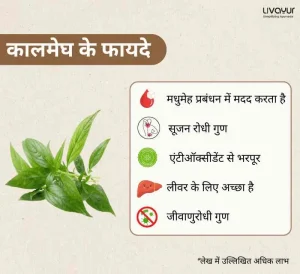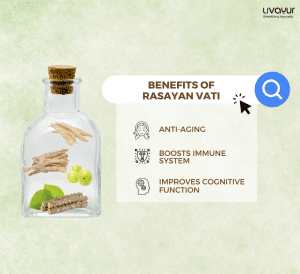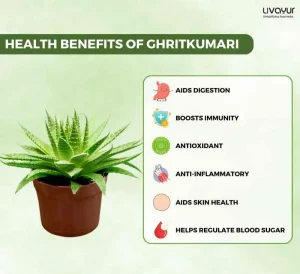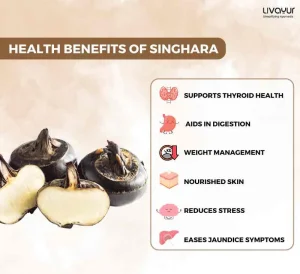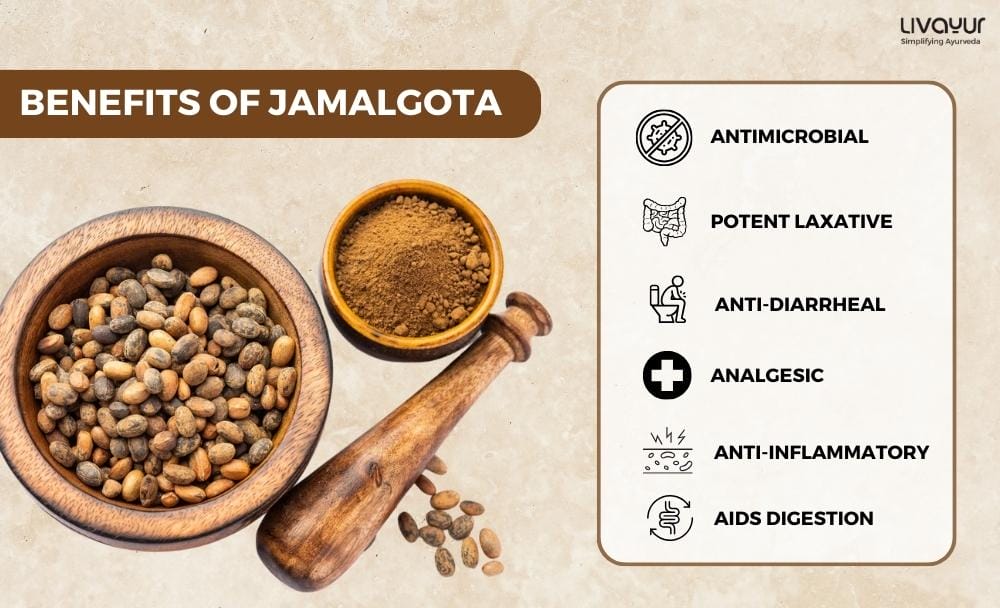
Jamalgota, scientifically known as Croton tiglium, is a plant that holds a significant place in ayurveda. This remarkable botanical called the “purging croton” or “jamalgota” has long been revered for its potent medicinal properties and versatile uses. It is a plant native to Southeast Asia and parts of Africa. It has been used for centuries in traditional medicine for its diverse properties and benefits.
Jamalgota is renowned for its potent medicinal qualities, with every part of the plant possessing therapeutic value. Its seeds, in particular, contain bioactive compounds like croton oil, which have been extensively studied for their pharmacological effects. Jamalgota is employed in various forms, including oil extracts, powders, and decoctions. In ayurveda, jamalgota has garnered recognition for its ability to address various health concerns and ailments, including digestive disorders and skin conditions. This article examines jamalgota, exploring its properties, uses, benefits, and more. We will provide valuable insights into harnessing its therapeutic potential for holistic well-being.
What is Jamalgota?
Jamalgota is one of the most potent laxatives in traditional medicine. Its action on bowel movement has a robust stimulant effect, prompting rapid bowel evacuation. This forceful action often leads to cramps during defecation and the passage of loose stools. Due to its formidable potency and the potential risks associated with its use, jamalgota is generally not recommended for most cases of constipation.
Safer alternatives in the form of laxatives are readily available in the market, offering gentler relief. However, it’s worth noting that in specific instances of severe constipation, a physician may consider employing jamalgota or similarly potent stimulant laxatives as a last resort to alleviate the condition. Caution and professional guidance are very important to ensure the safe and effective use of jamalgota. [1]
Different Names of Jamalgota
Here are a few prominent names by which jamalgota is known across southeast asia. This isn’t an exhaustive list of all the names of jamalgota but these are a few names that are more popularly used in different regions: [2]
- Jayaphala
- Dantibeej
- Rechaka
- Shodhani
- Ghantabeej
- Nepala
- Nervalam
- Purging Croton
- Croton tiglium
- Japalbij
- Japolota
- Narchalam
- Nepalamu
- Nikumbha beej
- Kuntini beej
Ingredients of Jamalgota [2]
| Components | Quantity |
| Toxalbumin | – |
| Crotonoside Oil | 50-60% |
| Linoleic Acid | Traces |
| Oleic Acid | Traces |
| Elcosenoic Acid | Traces |
- Active principle of croton tiglium is Crotin, a toxalbumin, which is an irritant & vesicant.
- A less poisonous glycoside, crotonoside is also present. Crotonoside (glycoside), oil contain powerful vesicating resin composed of crotonoleic acid, methyl crotonic acid, and several other fatty acids
- Jamalgota (Croton tilglium) kernels contain approximately 50 to 60% croton oil. Croton seed oil contains about 17 fatty acids.
Main Components are:
- Linoleic acid
- Oleic acid
- Elcosenoic acid
Ayurvedic Properties of Jamalgota
Here are the various properties of jamalgota according to ayurveda.
1. Rasa (taste)
It has a katu (pungent) taste, which imparts a sharp and spicy flavor profile. [1]
2. Guna (quality)
The guna (qualities) of jamalgota are described as guru (heavy), ruksha (dry), and tikshna (sharp), reflecting its substantial and desiccating nature. [1]
3. Virya (potency)
This herb exhibits ushna (hot) virya, signifying its heating and stimulating qualities. [1]
4. Vipaka (post-digestive effect)
The vipaka of jamalgota is katu, indicating its tendency to produce a spicy taste after digestion. [1]
5. Prabhav (special property)
One of the most noteworthy properties of jamalgota is its potent laxative effect, making it a formidable therapeutic agent in addressing bowel-related concerns. [1]
6. Dosha karma (effect on doshas)
Regarding dosha karma, jamalgota primarily pacifies kapha dosha, making it particularly effective when excessive kapha accumulation contributes to ailments. [1]
Uses of Jamalgota
Jamalgota, known for its diverse properties, finds utility in various therapeutic applications in traditional medicine. Some of its notable uses include the following.
1. Wound healing
Jamalgota finds use in wound care due to its potential antimicrobial properties, which may aid in preventing infections and supporting the healing process. [3]
2. Constipation relief
As a potent laxative, jamalgota helps alleviate severe cases of chronic constipation. Its robust laxative effect stimulates bowel movements, providing relief in situations where milder laxatives prove ineffective. [3]
3. Traditional dyspepsia
In traditional medicine, jamalgota helps address dyspepsia, a condition characterized by indigestion, discomfort, and bloating after meals. [3]
4. Dysentery and diarrhea
Jamalgota’s anti-diarrheal properties are recognized for their potential to alleviate symptoms of dysentery and diarrhea, relieving loose stools and related discomfort. [3]
5. Analgesic properties
Some traditional practices incorporate jamalgota as an analgesic to alleviate pain, although its use in this context requires careful consideration due to its potent nature. [3]
6. Antimicrobial activity
Jamalgota exhibits antimicrobial properties, which can be harnessed to combat microbial infections and inhibit the growth of harmful microorganisms. [3]
7. Insecticidal Properties
The plant’s insecticidal properties have made it valuable in traditional pest control methods, particularly agriculture. [3]
8. Anti-inflammatory effects
Jamalgota has anti-inflammatory properties, making it beneficial in reducing cellular inflammation associated with various health conditions. [3]
9. Antitumor potential
Some studies suggest that jamalgota may have antitumor properties, potentially inhibiting the growth of cancerous cells. [3]
10. Anti-HIV activity
Limited studies have explored jamalgota’s potential anti-HIV activity, hinting at its role in inhibiting the replication of HIV. [3]
Benefits of Jamalgota
Jamalgota, with its multifaceted properties, offers the following potential benefits in addressing various health conditions.
1. Gastrointestinal disorders
Jamalgota’s potent laxative and antidiarrheal properties make it valuable in managing gastrointestinal disorders. It can regulate bowel movements to overcome symptoms of constipation and diarrhea. Its effectiveness lies in its ability to stimulate intestinal peristalsis, aiding in the expulsion of waste and toxins from the digestive tract. Additionally, jamalgota contains compounds that can help restore the balance of gut flora, promoting overall digestive health. [3]
2. Intestinal inflammation
The anti-inflammatory properties of jamalgota may be beneficial in reducing inflammation in the intestines, offering relief to individuals suffering from inflammatory bowel diseases and related conditions. Its active constituents have been shown to inhibit the production of pro-inflammatory cytokines, thereby attenuating the inflammatory response in the gut. Regular consumption of jamalgota may contribute to the maintenance of intestinal integrity and function. [3]
3. Rheumatism
Jamalgota’s potential analgesic and anti-inflammatory effects may relieve the pain and discomfort associated with rheumatism, a chronic inflammatory condition affecting the joints and muscles. Its bioactive compounds exhibit properties similar to non-steroidal anti-inflammatory drugs (NSAIDs), providing relief from joint stiffness and swelling. Incorporating jamalgota into a comprehensive treatment plan may help manage the symptoms of rheumatism more effectively. [3]
4. Headache
In traditional practices, jamalgota helps alleviate headaches, possibly due to its analgesic properties. However, its use for this purpose needs a cautious approach. While some individuals may experience relief from headaches after consuming jamalgota, others may not respond favorably or may even experience adverse effects. It is essential to consult a healthcare professional before using jamalgota for headache relief and to explore other safe and effective treatment options. [3]
5. Peptic ulcer
Jamalgota’s ability to modulate digestive processes may be beneficial in managing peptic ulcers. It could help reduce acidity and discomfort associated with this condition. By promoting the secretion of protective mucus in the stomach lining and inhibiting the activity of gastric acid-producing cells, jamalgota may contribute to the healing of peptic ulcers and prevent their recurrence. However, caution should be exercised, as excessive consumption of jamalgota may exacerbate gastric irritation and worsen ulcer symptoms. [3]
6. Visceral pain
Some traditional applications involve using jamalgota to relieve visceral pain, which originates from internal organs. Its analgesic properties may play a role in providing relief from such discomfort. The compounds present in jamalgota act on pain receptors in the visceral organs, modulating pain signaling pathways and reducing the perception of pain. Integrating jamalgota into a holistic pain management approach may help alleviate visceral pain and improve overall quality of life. [3]
7. Haemorrhoids
Jamalgota’s properties extend to providing relief for hemorrhoids. Its laxative effect aids in softening stools, reducing strain during bowel movements, and easing discomfort associated with hemorrhoids. Additionally, its anti-inflammatory action may help alleviate swelling and irritation of hemorrhoidal tissues, promoting faster healing. However, caution is advised, as excessive use may exacerbate symptoms or lead to adverse effects.
Ayurvedic Uses of Jamalgota
Jamalgota has been used as a purgative for years in Ayurveda. Here are a few more uses:
- Jamalgota seeds are a widely used virecaka (purgative) and are used for quick action as Guṭīkās (tablet) and Churṇa (powder) to treat various diseases like Jwara (fever), Udara roga (disease of the abdomen), Gulma (abdominal lump), etc. They’re administered internally for these purposes.
- They’re applied on wounds and on joints externally for pain relief and healing purposes.
- Medicinal parts of jamalgota used often in Ayurveda are:
- Seeds
- Leaves
- Roots
- External bark of croton roots
- Seed oil (Croton oil, also called Crotonis oleum)
Recommended Dosage of Jamalgota
The appropriate dosage of jamalgota and its various forms needs administration with careful consideration of its potent properties and potential side effects. Dosage recommendations may vary based on the specific form of jamalgota. It is crucial to consult with a qualified healthcare practitioner or ayurvedic expert before initiating any jamalgota treatment. The following dosage guidelines are general reference points.
1. Purified jamalgota
Purified jamalgota has a typical range of 5 mg to 25 mg. This highly concentrated form requires precise measurement and expert supervision to avoid adverse effects. [1]
2. Croton root powder
The recommended dosage of croton root powder can range from 100 mg to 1000 mg, depending on the individual’s specific health condition and response to treatment. A healthcare professional should determine the dosage. [1]
3. External bark of croton roots
When using the external bark of Croton roots, dosages can range between 500 mg and 1000 mg. However, it is imperative to consult with a qualified practitioner to ensure proper administration and safety. [1]
4. Croton oil
Croton oil is highly potent, and its dosage is minimal. It has a dosage of one drop mixed with honey or butter. Due to its intensity, Croton oil should be strictly monitored and guided by a healthcare expert. [1]
It is essential to reiterate that jamalgota and its derivatives are potent substances that need great caution. Self-medication is strongly discouraged, and any use of jamalgota needs supervision by a healthcare professional well-versed in ayurvedic practices.
Side Effects of Jamalgota
Jamalgota is a plant known to contain certain poisonous compounds. Thus, thoroughly considering side effects and safety precautions is crucial before its administration. Extensive and indiscriminate use of this botanical may substantially threaten human health. Here are a few side effects one must be aware of:
- The informed application of jamalgota is essential to prevent any side effects. Adverse effects include severe cramps, diarrhea, abdominal pain, and dehydration. We have to use a certain amount of jamalgota to get the intended results. [3]
- If jayaphala is ingested in impure form or in excess, it will cause severe gastrointestinal irritation with burning pain in the abdomen, vomiting, powerful purging, and frequently a burning pain at the anus. When overdosed, collapse will be followed by death. [2]
- The oil of jayaphala causes external blistering, itching and irritation. [2]
- It isn’t recommended for the usage of pregnant women and lactating mothers. It is categorized as an upavisha and should be kept away from the reach of children as they wouldn’t be able to administer it properly without adult supervision.
Precautions with Jamalgota[2][4]
As discussed above, before using jamalgota we need to take a lot of precautions and be completely aware of the dosage to make sure that there are no harmful side effects, especially poisoning.
- Accidental poisoning results from swallowing croton oil by mistake, or when taken in large doses as a purgative or by inhaling their dust
- The jayaphala seeds shouldn’t be impure, the method of powder extraction should be pure and authentic too to make sure that there will be no fatal side effects on consumption.
- Suicide and homicide are rare but might happen.
- New mothers or pregnant women shouldn’t take this. It is not completely safe for their usage.
FAQs
1. What is jamalgota powder?
Jamalgota powder is a product derived from the seeds of the jamalgota plant, scientifically known as Croton tiglium. It finds use in traditional medicine for its potent laxative properties. However, use it with caution and under the guidance of a healthcare professional due to its toxic nature.
2. What is jamalgota oil?
Jamalgota oil is an oil extract obtained from the seeds of the jamalgota plant (Croton tiglium). It finds use in external applications and for its purgative and analgesic properties. It is important to note that this oil is highly potent and toxic, and qualified practitioners should strictly monitor its use.
3. What is the English name for jamalgota?
The English name for jamalgota is “purging croton.” It is a common name for the Croton tiglium plant due to its potent laxative effects.
4. What is the jamalgota plant?
The jamalgota plant, scientifically known as Croton tiglium, is a tropical shrub. It has excellent medicinal properties, particularly as a potent laxative. However, exercise caution when using any part of the plant, as it contains toxic compounds.
5. Can jamalgota be used for hair care?
While jamalgota has been used in traditional medicine for various purposes, including its potential antimicrobial properties, limited evidence supports its use for hair care. Consult a healthcare professional before using jamalgota or any herbal remedy for hair-related concerns to ensure safety and effectiveness.
Conclusion
Jamalgota is a unique botanical entity with a rich history in traditional medicine. Its properties, uses, and benefits testify to its potent nature and therapeutic potential. While it offers various medicinal applications, it also demands the utmost caution and professional guidance due to its toxic constituents.
The ancient wisdom of ayurveda reminds us that harnessing the power of jamalgota requires a delicate balance between its potential benefits and the need for responsible and supervised usage.
Disclaimer
The information provided here does not intend to replace professional advice or treatment.
References
- MEDICINAL USES OF JAYAPALA (CROTON TIGLIUM LINN): A REVIEW ARTICLE. 25 September 2019
- According to Modern science Jaypal i.e. Croton tiglium is included as an Irritant organic vegetable poison.
- A Comprehensive Review on Medicinally Important Plant, Croton Tiglium L. July 2018
- A critical review on Upavisha- Jayapala (Croton tiglium)









